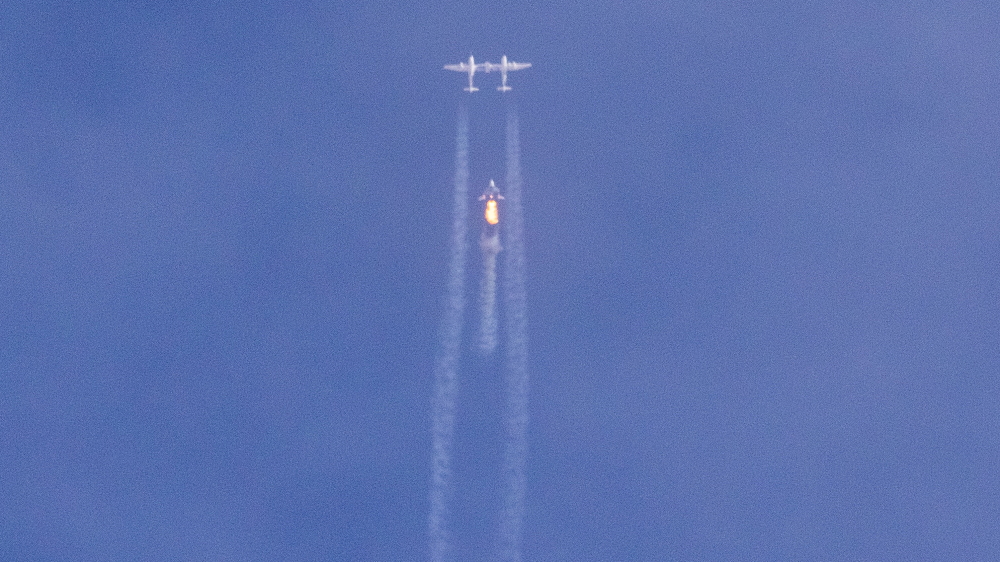
SpaceShipTwo in the assembly and testing facility, photo by Virgin Galactic
The launch of VSS Unity, which has already become 19 for the spaceplane, was filmed by space enthusiasts from the site Nasaspaceflight.com, and thanks to them we have quickly published footage of what happened. If you wish, you can watch the broadcast (from 1:22:59), but the photo is slightly better in quality.

Photo by Jack Bayer / Nasaspaceflight
After the spaceplane was dropped from the WhiteKnightTwo carrier aircraft, it seems that everything is normal - the flame of the turned on engine is perfectly visible.

Photo by Jack Bayer / Nasaspaceflight
But it was not so - the next photo shows the engine shutdown.

Photo by Jack Bayer / Nasaspaceflight
And the last photo is the most interesting. Here we see, obviously, the drain of the oxidizer. SpaceShipTwo hybrid engine - solid fuel is made on the basis of HTPB polybutadiene, and the oxidizer, nitrous oxide, is liquid. For the task of transporting space tourists, this is a very interesting choice - the components are non-toxic, should not be stored at low temperatures, and, unlike a solid fuel engine, a hybrid one can be turned off even a second after ignition. However, despite the seemingly simplicity, the engine for the spaceplane was developed for a long time, with a lot of problems and even a catastrophe with human victims in 2007.
The incident showed the adequacy of the safety measures laid down in the flight plan - the carrier aircraft drops the SpaceShipTwo at a point from which it is able to glide to the airfield even in the event of a complete engine failure. In fact, the flight plan is structured so that a safe return to the airfield is possible at any time. And the design of the spaceplane survived the landing with an additional load of unspent solid fuel checkers in the rear of the fuselage. However, VSS Unity has not yet reached its standard operational weight - work continues to shape the appearance of the passenger cabin, and there were no tourists on board.
Failure to comply with the flight program did not prevent to shoot and publish nice footage of the landing of the device. Nothing special is noticeable here, a small detail with a white and red color protruding under the belly is a standard air brake, clearly visible in other photographs.
Within 24 hours after the accident, Virgin Galactic was named the direct cause of the accident - the on-board computer that controlled the rocket engine lost its connection, and an automatic emergency procedure stopped the engine. The company said that the date of the next flight and additional information about the incident will be announced later.
VSS Unity is the second instance of SpaceShipTwo. The first, VSS Enterprise, was lost in a crash in 2014... The flight on December 12 for VSS Unity became the twentieth in the company's account, but different sources, depending on the definition of the flight, indicate different numbers. In December 2018 and February 2019, the spaceplane climbed above 50 miles, the limit of space as defined by NASA. Starting in 2020, flights are carried out from Spaceport America (New Mexico), and the launch on December 12 was positioned as a milestone - the state of New Mexico would become the new place from which people were sent into space (albeit along a suborbital trajectory). The spaceplane was piloted by NASA shuttle program veteran Wilford Sterkow (4 orbital flights) and Virgin Galactic test pilot David Mackay. Also on board were NASA-sponsored Flight Opportunities experiments.
Virgin Galactic with the SpaceShipTwo spaceplane, like their closest competitor, Blue Origin with the New Shepard reusable rocket, has been working on suborbital space tourism systems for many years. Despite repeated plans to send the first tourists "next year" and more than a dozen test flights for each of the projects, the launch date for the first suborbital tourists, some of whom purchased tickets years ago, is still uncertain.